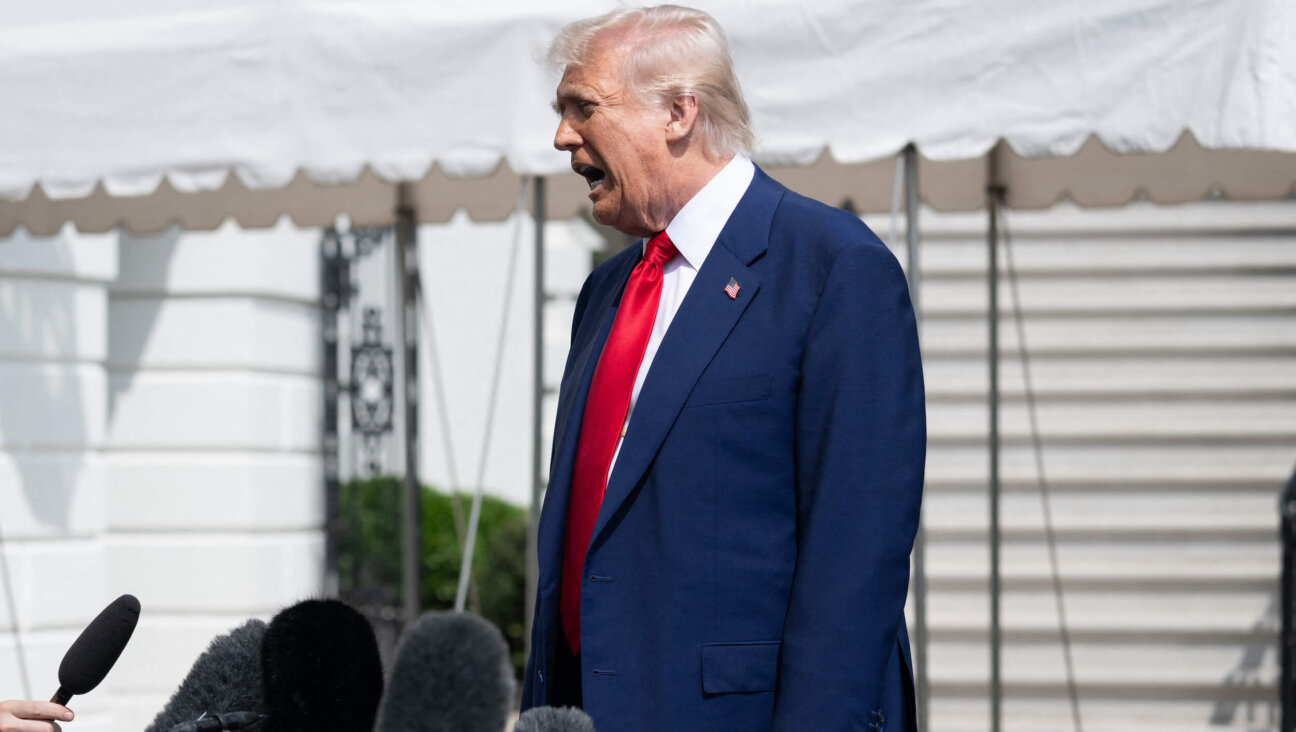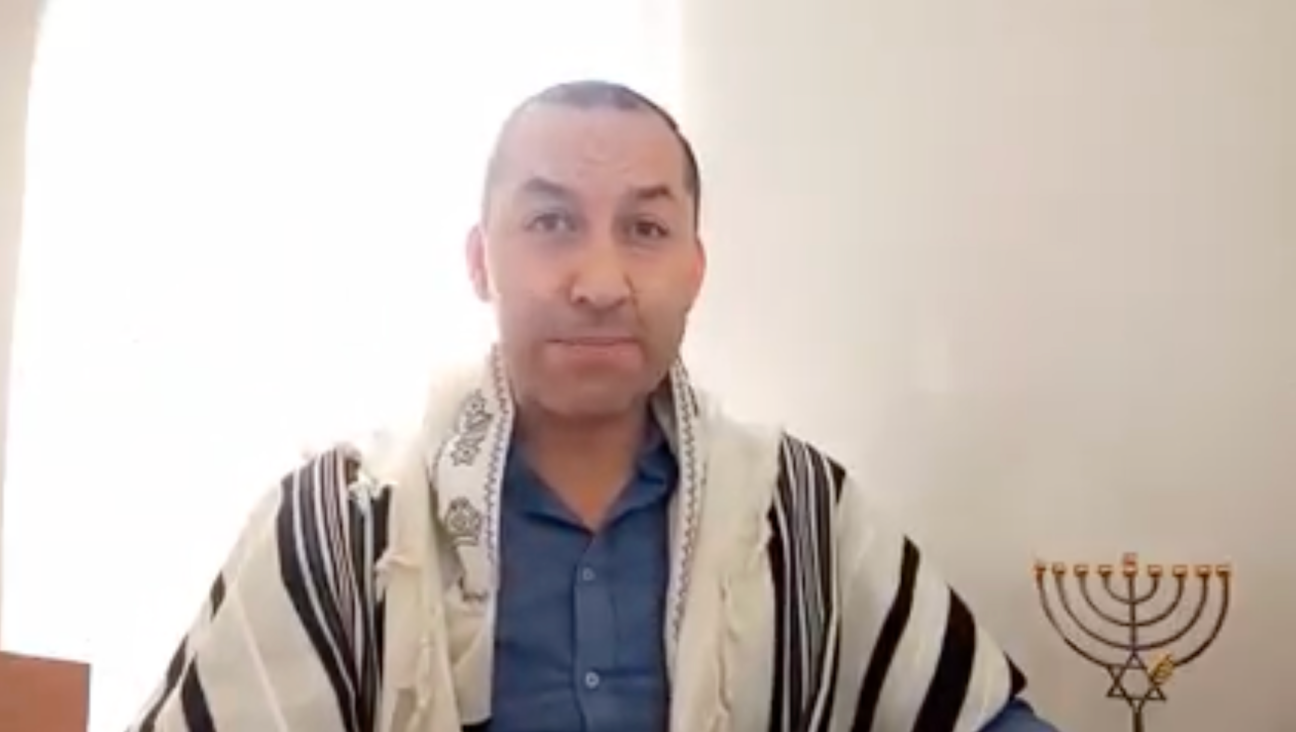Espionage Ruled Out in Case of Bad Art
Is it espionage or — worse — bad art?
While officials in the United States are busy grappling with the question of whether Pentagon analyst Larry Franklin passed sensitive information to Israel and compromised national security, authorities in our neighbor to the north are trying to tamp down speculation that a platoon of goateed and dreadlocked Israeli art students who infiltrated Canada may have been working as spies.
The Israeli embassy in Ottawa has emphatically denied any link to the students and is dismissing allegations of possible espionage bandied about on the Internet. The claims also have been raised in Canadian newspapers, but with caveats and disclaimers, and then flatly rejected as “preposterous.” Government officials in Canada also insist that no evidence exists to suggest that the students who were picked up last month in Calgary, Winnipeg, Saskatoon, Toronto and Ottawa and deported were part of a fifth column targeting the far side of the 49th parallel.
The students and their handlers, Guy Grinberg and Jackie Yakov Senior, were charged earlier this month under Canadian law with working in the country illegally, and faced no other charges, said Robert Ferguson, director of immigration enforcement for the Canada Border Services Agency in Canada. A similar operation gained widespread media attention amid allegations of espionage when it surfaced in the United States in 2000.
In the most recent case, government authorities in Canada have insisted that all the evidence collected indicates the young, self-described “art students” — all of them Israelis in the country on visitor’s visas — were involved in something far more prosaic than espionage: the importation of tragically bad, dirt-cheap paintings from the Far East that were then sold at wildly inflated prices door-to-door in some of the more upscale neighborhoods in western Canada. In some cases, the paintings sold for more than 100 times their value, prompting authorities in Calgary to issue a warning to the public to be wary of art fraud, said Detective Frank Cattoni of the Calgary Police Department. The alert made no mention of espionage.
“We have no… information in our possession other than to indicate that they were selling art… and that’s how our department dealt with it,” Ferguson said. “Basically, they were seen as working illegally.”
But the official declarations have not succeeded in quelling all public uneasiness about the art students and their motives, talk that has dogged reports of the operation on both sides of the border for more than three years.
In an August 7 report on the detention of 15 members of the Canadian ring, for example, the Calgary Herald declared that the door-to-door art scam “has for years puzzled authorities on both sides of the U.S.-Canada border and raised the specter of international espionage.”
The art-selling operation, which first surfaced in the United States in 2000, has been reported on by The Washington Post, Fox News, Salon.com, Ha’aretz and most extensively by the Atlanta-based alternative newspaper Creative Loafing. It has for three years now been a hotly debated topic among amateur spy watchers and on conspiracy theory Web sites.
Over the years, government officials from the United States, Israel and Canada have all officially dismissed speculation about the ring. In one instance, an American official described allegations of spying as “an urban myth.” Despite all the media attention, no evidence has ever been uncovered proving that the operation involves anything more than college-age students, recruited by handlers in Israel, to go door-to-door trying to persuade office managers and affluent housewives to pay up to several thousand dollars for $20 paintings hammered out in Far Eastern workshops.
Reports of the scam and allegations that it might be a front for Israeli espionage first surfaced in the United States in 2000, when American officials, among them agents of the federal Drug Enforcement Administration, first began noticing that as many as 120 young Israelis, many of them veterans of the Israeli military’s intelligence corps or experienced in signal interception and ordnance, were traveling door-to-door from Atlanta to Texas. They often turned up at offices of the DEA and other government agencies, on one occasion at Tinker Air Force Base in Oklahoma, where American spy planes are serviced, and on several occasions at the homes of federal law enforcement agents. In at least one case, the students were spotted in an Atlanta-area office that housed an FBI office not widely known to the public.
A 60-page draft report detailing the students’ activities was compiled by a DEA agent and later leaked to the press. Among other things, the report’s author, who never has been identified, warned that it was entirely possible that the operation actually was “an organized intelligence-gathering activity.”
The report did not conclusively point the finger of blame at anyone. But John Sugg, an associate editor for Creative Loafing and the first journalist to publish details of the report, said his sources opined that it was possible the students could have been trying to glean information for the Mossad, perhaps as part of an operation to monitor Arab groups in the United States and the American government’s reaction to them. But, Sugg said, it was equally possible that they were targeting DEA and related offices on the orders of Israeli organized crime factions that were then consolidating their control over the illicit Ecstasy market.
By March 2001, federal anti-espionage authorities were concerned enough about the Israeli art students to issue a warning to government officials to be on the lookout for attempts to infiltrate federal buildings.
At that point, the alert was a closely held secret among federal agents. But on December 12, 2001, three months after the attacks on the World Trade Center and the Pentagon, Fox News reported that dozens of Israelis, among them art students, had been arrested on immigration charges and were suspected of spying on the United States. They were deported and faced no additional charges. In the months that followed, Sugg and the French newspaper Le Monde published stories detailing the contents of the DEA report. Months later, the Forward also raised the specter of Israeli espionage, publishing a report that the art students were suspected by some to be part of a larger operation, an operation that came to light with the arrest of five Israeli citizens on September 11, 2001. All five were deported even though, according to a former American official briefed on the case, “a counter-intelligence investigation by the FBI concluded that at least two of them were in fact Mossad operatives.”
Reporters for several major newspapers, including The Washington Post and The New York Times, looked into the allegations as well, but were never able to find a conclusive link between the art students and either the Mossad or the underworld.
In fact, in its report, the Washington Post quoted government officials who downplayed the significance of the DEA report, claiming that it was the work of one disgruntled employee who was unhappy that higher-ups were not taking seriously enough his warnings of possible Israeli espionage in the United States.
But still the story wouldn’t die.
As late as last year, the respected Internet magazine Salon.com revived the spy ring allegations in a lengthy and detailed report recounting the charges and suggesting that the group may have been operating in as many as 40 American cities.
By that point, however, the operation had moved across the border to Canada. According to Canadian officials, the operation took root there in 2002, about the same time as it began to peter out in the United States. But there was a difference. Canadian officials insist that unlike the events detailed in the DEA report in the United States, there was no evidence that the art scammers in Canada targeted government officials or government offices. Instead, the ring seemed to focus exclusively on wealthier neighborhoods.
Ofir Gendelman, spokesman for the Israeli embassy in Ottawa, says the students, many of whom, he quickly noted, “are from good families,” are recruited for the overseas art scam by scurrilous business people using newspaper ads and word-of-mouth solicitations. Not only are they not spies, he says, but in most cases, they also are so gullible that they don’t even know they’re being hired to work illegally. “They have no idea,” Gendelman said. “The people who run those companies tell them that because [the recruiters are] legal here those Israelis are also legal, and so they eat the bait.”
Such gullibility is hardly a qualification for spy duty, and Gendelman freely expressed frustration with the persistence of rumors of a cloak-and-dagger operation involving the young students. “It’s ridiculous,” he said. “Those allegations are absolutely baseless.”
And there are many, both inside and outside government, who agree.
While the original allegations of espionage in the United States were controversial and lacked real evidence, they were not wholly beyond the realm of possibility, said Chip Berlet, an expert in intelligence operations who also studies conspiracy theories at Boston-based Political Research Associates.
“If I were an intelligence agency and I wanted to hide people, I might pick this kind of group,” Berlet said. “On the other hand, it’s unlikely that everyone in the group would be intelligence agents because then there wouldn’t be a cover.”
Even if there were some kernel of truth to the original spying allegations, it is unlikely, Berlet said, that such an operation would have survived the media storm it encountered when details of the DEA report surfaced in the United States. It’s even more unlikely, he says, that such an operation would be resurrected immediately afterward in Canada or anywhere else.
“It strains credulity that once you have an operation blown, you’d simply recycle it,” Berlet said. “That’s almost unheard of; that’s not done. You’re placing your agents at too high a risk.”
The Forward is free to read, but it isn’t free to produce

I hope you appreciated this article. Before you go, I’d like to ask you to please support the Forward.
At a time when other newsrooms are closing or cutting back, the Forward has removed its paywall and invested additional resources to report on the ground from Israel and around the U.S. on the impact of the war, rising antisemitism and polarized discourse.
Readers like you make it all possible. We’ve started our Passover Fundraising Drive, and we need 1,800 readers like you to step up to support the Forward by April 21. Members of the Forward board are even matching the first 1,000 gifts, up to $70,000.
This is a great time to support independent Jewish journalism, because every dollar goes twice as far.
— Rachel Fishman Feddersen, Publisher and CEO
2X match on all Passover gifts!
Most Popular
- 1

Opinion Trump’s Israel tariffs are a BDS dream come true — can Netanyahu make him rethink them?
- 2

Opinion My Jewish moms group ousted me because I work for J Street. Is this what communal life has come to?
- 3

Opinion I co-wrote Biden’s antisemitism strategy. Trump is making the threat worse
- 4

Film & TV How Marlene Dietrich saved me — or maybe my twin sister — and helped inspire me to become a lifelong activist
In Case You Missed It
-

Fast Forward Colombia appoints allegedly fake anti-Zionist rabbi as director of religious affairs
-

Fast Forward GOP Rep. Randy Fine, the newest Jewish congressman, calls Rashida Tlaib a ‘terrorist’
-

Fast Forward Freed hostage Liri Albag responds to backlash over Netanyahu criticism: ‘I fear what we have become’
-

Fast Forward France will move to recognize a Palestinian state this year, Macron says
-
Shop the Forward Store
100% of profits support our journalism
Republish This Story
Please read before republishing
We’re happy to make this story available to republish for free, unless it originated with JTA, Haaretz or another publication (as indicated on the article) and as long as you follow our guidelines.
You must comply with the following:
- Credit the Forward
- Retain our pixel
- Preserve our canonical link in Google search
- Add a noindex tag in Google search
See our full guidelines for more information, and this guide for detail about canonical URLs.
To republish, copy the HTML by clicking on the yellow button to the right; it includes our tracking pixel, all paragraph styles and hyperlinks, the author byline and credit to the Forward. It does not include images; to avoid copyright violations, you must add them manually, following our guidelines. Please email us at [email protected], subject line “republish,” with any questions or to let us know what stories you’re picking up.















